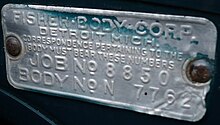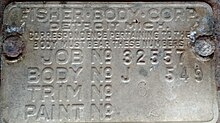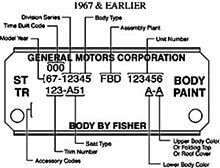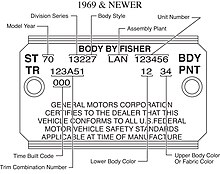User:Gtofever/Fisher Body Tag
| This is not a Wikipedia article: It is an individual user's work-in-progress page, and may be incomplete and/or unreliable. For guidance on developing this draft, see Wikipedia:So you made a userspace draft. Find sources: Google (books · news · scholar · free images · WP refs) · FENS · JSTOR · TWL |
A Fisher Body Tag (aka Body Number/Body Data/Cowl Tag/Plate) was a code-stamped sheetmetal tag[1] attached to automobile bodies built by Fisher Body for General Motors (GM) divisions (Buick, Cadillac, Chevrolet, GMC, Oldsmobile, and Pontiac). Typically rivetted to the drivers side of the firewall, the Body Tag's purpose was to provide assembly workers the info they needed to construct that particular body. Body Tags were installed from at least 1929 until the mid-1980s.


The first tags contained just a Job# and the Body# (assembly sequence number), but later year's tags added codes that also specified:
- most of the identification information also in the VIN (model year, model series, body style, assembly plant)
- much of the assembly data (build date, paint color, trim combination, and options/accessories).
- If option/accessory codes were provided, only those affecting assembly/modification of the body shell were included; thus, the ACC codes on the tag are not a complete record of all options installed on a given car. For example, hubcap selections would not be stamped on the Body Tag.
Tag layouts were standardized, but code content varied as each Fisher factory followed its own rules, especially in regard to ACC codes. For example, factory codes could be 1-3 digits.
Details
[edit]




The tag was attached to the body very early in the assembly process, before paint was applied. Mostly, tags were painted along with the firewall, but sometimes they were masked off.
Fisher divided the tag into several sections, usually labeled: PAINT/PNT (exterior), TRIM/TR (interior), factory data BODY/BDY, and STYLE/ST. The Time Built Code area was not labeled.
The lower portion of the body tag was the options section, sometimes unlabeled, and sometimes labeled ACC.
From 1964-72 there were 3 basic tag styles: 1964-67, 1968, and 1969-72.[2]
Build Date Code
[edit]The specific day of manufacture cannot be derived from tag data. Typically, the 3-digit build date code used the first two digits (01 - 12) to identify the month, and 3rd digit (A - E) to identify the week (Example: 05B = 2nd week of May). Generally, most date-coded components on the car were built between 2 and 8 weeks before the build date of the body.
| Build Week | 1 | 2 | 3 | 4 | 5 |
|---|---|---|---|---|---|
| Code | A | B | C | D | E |
Body Style Number
[edit]The style number (tag header "Style" or "ST") was a combination of model year (2-digit), car division code, model series code, and body type code
(Example: 2267 decodes 2 = Pontiac, 2 = Lemans, 67 = Convertible).
Model Series codes are too numerous to list here.
| Code | Division |
|---|---|
| 1 | Chevrolet |
| 2 | Pontiac |
| 3 | Oldsmobile |
| 4 | Buick |
| 6 | Cadillac |
| C | Chevrolet Truck |
| T | GMC Truck |
| Code | Body Style |
|---|---|
| 11 | 2-door sedan — 6 passenger |
| 17 | 2-door hatchback |
| 27 | 2-door sport coupe — 5 passenger |
| 35 | 2-door station wagon — 6 passenger |
| 37 | 2-door hardtop |
| 41 | 4-door station wagon — 2 seat, 6 passenger |
| 45 | 4-door station wagon — 3 seat, 9 passenger |
| 67 | 2-door convertible — 5 passenger |
| 69 | 4-door sedan — 6 passenger |
35 == 4-door Station Wagon—2 Seat, 6 Passenger 37 == 2-door Sport Coupe—5 Passenger 49 == 4-door Sedan—6 Passenger 47 == 2-door Super Sport Coupe — 5 Passenger
Trim Codes
[edit]The trim code (tag header "Trim" or "TR") indicated the trim material (1st digit) and color (2nd & 3rd digits). Example: 214 = black vinyl.
There may or may not be an additional code following the trim code that identifies the type of seat installed in the car.[3]
| Code | Material |
|---|---|
| 2 | Vinyl |
| Code | Color |
|---|---|
| 14 | Black |
| 15 | Dark Blue |
| 16 | Saddle |
| 17 | Dark Aqua |
| 18 | Medium Red |
| 19 | Parchment |
| Code | Description |
|---|---|
| A41 | 4-way front power seat (bench) |
| A46 | 4-way front power seat (bucket) |
| A51 | Front Strato bucket seat |
| A75 | H.D. front bench seat |
| A81 | Headrest (Strato seat type) |
| A82 | Headrest (Conventional seat type) |
Paint Codes
[edit]The paint code indicates the exterior paint color and vinyl top or convertible top color (if so equipped). From 1964 to mid-1969, a two-digit code indicated the lower body and top (roof, vinyl top, or convertible top) respectively (1964 Chevrolets codes used 3-digits). From mid-1969 to 1972, all divisions used a 2-digit code for the lower color, followed by a 2-digit code for the roof paint, or a letter for the vinyl roof or convertible top color.
Accessory/Option Codes
[edit]Of course, dealer-installed accessories were added after the car left the factory, so those option codes would not be stamped on the Body Tag; the dealer-installed accessory brochures for each year provide the list of such items.
Option codes were not applied to Body Tags from 1968-69.
Group Option Codes
[edit]From 1964-67, the 2-digit Group Option code system was used; the 1st digit was the Option Group number (1-5), followed by a letter (A-Z) for each option in that group. Group Option codes were stamped in sequence by group (the number 1 was usually omitted), but used three different formats:
- Separate codes, example: 1D 2C 2E 2S 4W 5N 5X
- Organized by group, example: D 2CES 4W 5NX
- Bunched together, example: D2CES4W5NX
Many Group Option codes have been decoded for Chevrolet and Pontiac vehicles; Buick and Oldsmobile codes to a much lesser extent.
RPO Codes
[edit]ACC/Option codes reappeared on Body Tags in 1970[4], but a switch was made to the RPO code system. Beginning as early as 1967[5], and to all GM models since 1984, GM attached a Service Parts Identification (SPID) label that contained most of a vehicle's RPOs.
Engine Codes
[edit]GM was the last of The Big Three US automakers to apply engine codes in the VIN and Body Tag, beginning in 1972 (Ford started in the 1950s, and Chrysler began in 1966).[6]
Sequence Number
[edit]The unit or build sequence number told where that body fell in the production sequence for that model at this factory. To the left of the BODY or BDY letters is the unit number assigned at Fisher Body. This number will not match any numbers in the VIN and is not significant for identification or restoration purposes.
Assembly Plant (Factory
[edit]
The assembly plant code (1-3 characters) identifies where the car was built (Example: BA = Baltimore)
| VIN Code |
Tag Codes (1-3 Letters) | Year | |||||
|---|---|---|---|---|---|---|---|
| 1 | 2 | 3 | Factory | Start | End | GM Platforms | |
| R | R | BT | Arlington TX | 1954 | B/D/G-body | ||
| A,8 | A | AT,AG | ATL | Atlanta (Lakewood) GA | 1927 | 1990 | |
| B | B | BA,BM | BAL | Baltimore MD | 1935 | 2005 | A-body |
| V | V | Bloomfield IL | 1965 | ||||
| 5 | Bowling Green | ||||||
| Q | Detriot MI | ||||||
| 9 | Detroit (Cadillac) | Cadillac | |||||
| 3 | Detroit (T&B) | ||||||
| D | C,D | Doraville GA | 1947 | 2008 | A/B/Y-body | ||
| X | Fairfax (KS) | 1947 | 1987 | ||||
| F | F | Flint MI | 1947 | * | C/K, pickups, Vans | ||
| H | Flint MI (Buick City) | 1904 | 1999 | Buick | |||
| G | G | FR | FRA | Framingham MA | 1947 | 1989 | A-body |
| F | Z | BF,FE | Fremont CA | 1960 | 2009 | ||
| Q | J | J | Janesville WI | 1919 | 2009 | C/K trucks | |
| X | Kansas City KS | ||||||
| K | M,K | KC | KAN | Kansas City MO | 1971 | A-body | |
| L | L | VN | LOS | LA/Van Nuys CA | 1947 | 1992 | A/B/F/X-body, Corvair |
| C | LA | Lansing (Buick) | |||||
| M | Lansing MI | 1992 | 2005 | J/N-body | |||
| K | Leeds MO | 1929 | 1988 | A/J-body | |||
| Q | |||||||
| Q | |||||||
E E BL Linden NJ 1937 2005 S-series, K/L-body U U,7 LOR Lordstown OH 2 Moraine OH (T&B) 1951 2008 Mid-SUVs (GMT3x0s) N N NW NOR Norwood OH 1972 6 Oklahoma City 4 Orion MI 9 Oshawa #1 1 O,0,1 OS Oshawa ON A-body P P PO PON Pontiac MI 1927 1988 Pontiac V Pontiac MI (GMC) 0 Pontiac MI (Truck) 1972 2009 Pickups 4 Scarborough ON 1963 1993 Vans 8 Shreveport S C,U BC -- Southgate CA 3 St. Eustache QC S S St. Louis MO 2 2 ST St. Therese QU 1972 T T Tarrytown NY 1896 1996 Truck,Bus,U/W-body L L Van Nuys (LA) CA 1 Wentzville OH W W WR Willow Run MI 1972 Y Y BW Wilmington DE
The body # was the production serial number of the body.
History
[edit]Starting in 1910, Fisher became the supplier of all closed bodies for Cadillac, Buick, Oakland and Oldsmobile. In 1926 Fisher was integrated entirely as an in-house coachbuilding division of General Motors. GM vehicles (except the fiberglass bodied Corvette) each displayed a "Body by Fisher" emblem on their door sill plates until Fisher Body's demise in 1984.
A Regular Production Option (RPO) is a 3-digit code 1950s (see Corvette C1). It was originally all numeric and labeled Sales Codes; in 1970 GM switched to the alphanumeric RPO code.
both standard components (like engine, transmission, and paint color) and extra cost options are assigned codes.
The complete configuration of a GM vehicle (as it exited the factory) can be described by specifying the base model and a complete list of its RPO codes.[7] SPID Reproductions]</ref>, and to all their models since 1984, GM attached a Service Parts Identification (SPID) label. The label is most often located on the back of the glovebox door, on the inside of the trunk lid, or on the bottom of the spare tire cover. On some of the GM SUVs and mini-vans, the SPID label will be located on one of the plastic storage covers in the rear of the vehicle.
The SPID lists, in alphabetical order, many of the options built into a vehicle, both RPOs and the older and longer Option Model#s[8] (sometimes used before 1970). These codes are sometimes needed during vehicle repairs to select the correct replacement parts. TECH TIP: Take a photo of the Vehicle Identification Number (VIN) and the SPID with you when purchasing auto parts. NOTE: Reproduction SPID labels may be purchased online from aftermarket vendors.
In 2018, the RPO Sticker was replaced by a QR code label located on the B-pillar (driver's side, between front and rear doors). While fairly complete, it does not contain every RPO that is on the vehicle.
RPO code details & format
[edit]RPOs may be generic options (available on all models over many years), or specific options (available only on specific models for limited years). RPOs codes are assigned to align with specific component groups and with UPC groups as tabulated below:
See Also
[edit]Regular Production Option (RPO)
References
[edit]- ^ [- Wiktionary definition 1.1]
- ^ Drivinithome.com - GM-body-tag-decoding
- ^ Drivin It Home.com - GM Body Tag Decoding
- ^ Drivinithome.com - GM-body-tag-decoding
- ^ outintheshop.com SPID Reproductions
- ^ GTO Data and ID Guide 1964-1974 by Peter C. Sessler 2018
- ^ Whipps, Kevin (2018). How to Restore Your Chevy Truck 1973–1987. CarTech. p. 71. ISBN 978-1-61325-199-7.
- ^ 67-72chevytrucks.com SPID pictures
External links
[edit]

